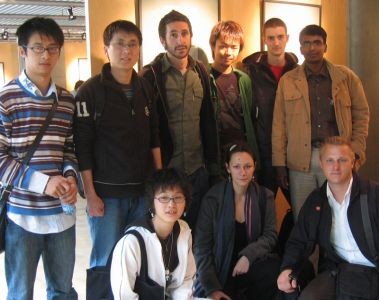
Apr 18, 2007
- Marina van den Bergen
Midterm review group 6
You are asked to design a high-density residential enclave on the site. What will you do? Just do it?
The participants came up with four different proposals.
1 Mirror and Layers.
\'We want to make the building on our site to be a mirror to reflect the development of the city and add some kind of layers to send for the history of Shanghai.
2 Identity Crisis?
Looking for ways how a skyscraper can address the public space and therefore the city.
3 Advertisement House.
A proposal for low-income housing in low-rise buildings without having the people to move from the Donjiandu area, and still make it economic attractive for developers. Key idea is the use of advertisement on the houses. Like making a line of kitchens, that at the same time is a showroom for a kitchen manufacturer. The same strategy can be applies for toilets and bathrooms. Containers are used for bedroom and living room. On the side of the containers there will be advertising. By pilling up the containers random, the advertising is still visible and the space between the containers can be used as a playground for childeren
4 Urban fabric over water.
Water over water in the water. Excess to the river must be insured and preserved. To make this possible a diverse programme is add to horizontal objects along the riverbanks. The programme consists of sports, leisure, infrastructure, houses, industry etc. Industry will be situated below ground floor level, on the ground floor and the first floor there will be public services, the others floors are for housing. But all functions can and will be mixed.
(image Mirror and Layers)
Mar 26, 2007
The brief
Shanghai’s architecture is buzzing with visions, and investors and politicians are focusing on the difference that architecture can make for the city. Latest developments in Shanghai however can be diagnosed as sameness, gated-ness and fakeness.
Coming from a strong tradition for social awareness, artistic ambitions and progressive thinking, so called ’correct’ architects are skilled at incorporating the human aspects of architecture, and are continuously experimenting to come up with sustainable and responsible building solutions.
New rising middle class in Shanghai seeks comfort, security and identity in newly developed areas which often use borrowed architectural language and enclosed planning strategy. These enclave developments are mini capsulars with controlled access and isolate itself from the world outside.
What are the reasons behind the ex-/in-clusion? Can simulacra - copy of the copy of the copy - produce interesting new conditions? What are the mechanisms – fear, prestige, privacy, mobility - behind the selling strategy? What are the consequences of privatisation, exclusion and fortification? What are the architectural and planning strategies underlying the designs?
Ultimately, you are an architect, in this workshop you are asked to design a high density residential enclave on the site; WHAT WILL YOU DO?
Ir. Ruurd Gietema
Urban planner and partner in KCAP.
Ruurd Gietema was born in 1964 in Tjerkwerd, Friesland. He graduated from Delft University of Technology (TU Delft) as an urban planner in 2002. During his studies he worked for a number of internationally active bureaus, including UN Studio, West 8 and MVRDV. He received the Maaskant Prize for Young Architects in 1999.
He has been working at KCAP since 1996, joined the team of directors in 1999 and has been a partner since January 1, 2002. Within KCAP his focus is on large-scale urban development projects in cities that include Zurich, London, Hamburg, Helsinki, Ghent, Antwerp, Beijing, Shanghai, Amsterdam, Rotterdam and The Hague.
He lectures in the Netherlands and abroad and has been attached to various education institutions. He regularly participates in competition juries, such as Europan or the Prix de Rome. From 2001 to 2005 he was also a member of the architecture committee of the Netherlands Foundation for Visual Arts, Design and Architecture (Fonds BKVB).











